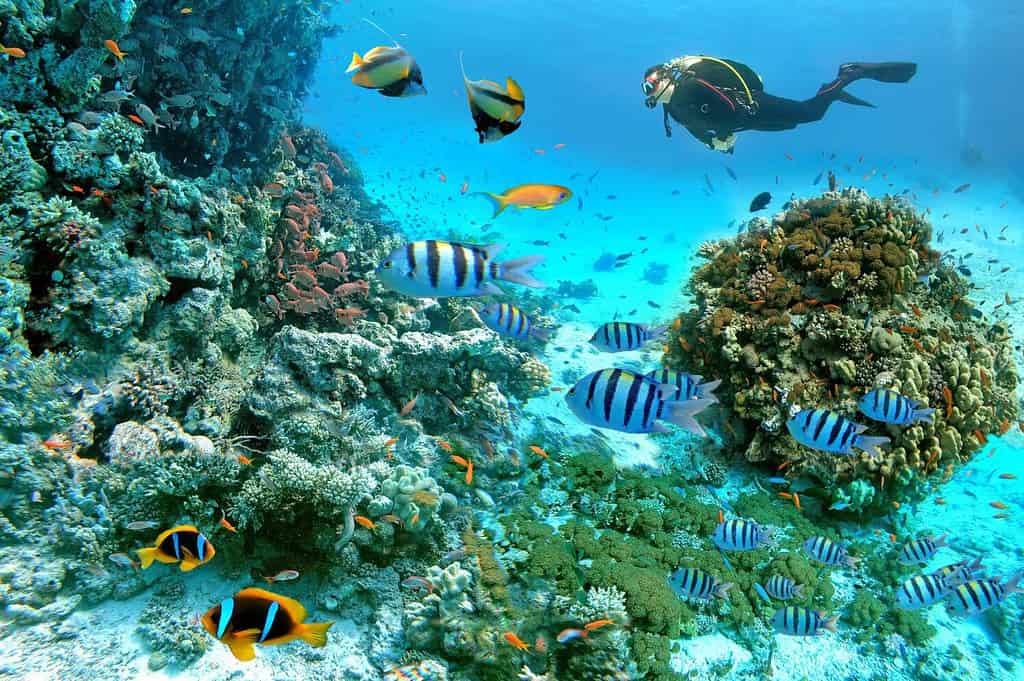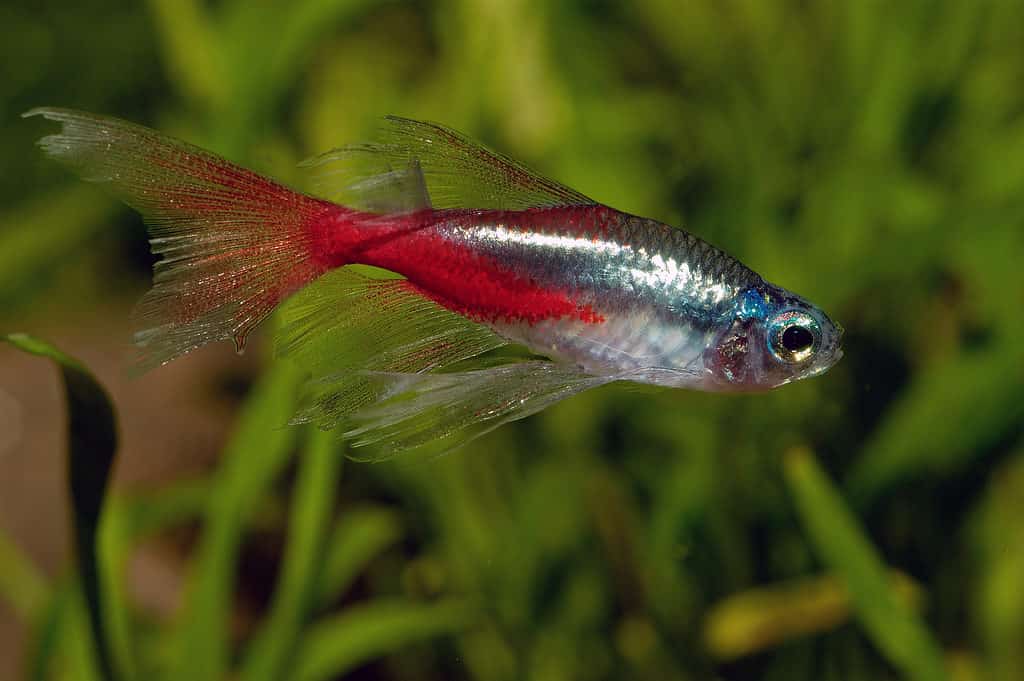Over 35,000 species of fish inhabit Earth’s oceans and freshwater. Among them, an incredible diversity of intra and interspecific communication exists. This range of communication methods includes body language, acoustic signaling, motion, chemical signaling, bioluminescence, color, and electrical pulses.
In this guide, we’ll cover examples of these methods across diverse fish species. Read on to learn about how fish communicate with each other.
How Fish Communicate: Body Language
From apex predatory sharks to tiny schooling minnows, many fish species use body language to communicate.

Body language is an important communication method for social fish species.
©branislavpudar/Shutterstock.com
Shark Agonistic Displays
In many shark species, agonistic displays heavily rely on body language. For example, a threatened gray reef shark (Carcharhinus amblyrhynchos) will display a hunched back, uplifted snout, downward-pointing pectoral fins, and a curved body. A threatened basking shark (Cetorhinus maximus) will clamp its mouth shut in a cessation of filter-feeding and present with downward-pointing pectoral fins.
Flank Displays and Mouth Gaping
In competitive environments, many fish species display their flank to each other. The neon tetra (Paracheirodon innesi), a colorfully striped freshwater fish from the Amazon basin, will adopt a rigid posture and display its flank with out-held fins to its conspecific (of the same species) competitor. Some species of gobies, such as the Western Pacific-ranging Acentrogobius virgatulus, display mouth gaping during agonistic interactions.

The colorful neon tetra will display its flank during agonistic interactions with conspecifics.
©NERYXCOM/Shutterstock.com
Acquiescing Body Language
To signal acquiescence to an aggressor some species of fish will display a lowered body position, retracted fins, or lifted head to display acquiescence to an aggressor. In a 2020 study on the social daffodil cichlid (Neolamprologus pulcher), researchers found that this species will use a head-up posture to signal submission to a stronger individual. Researchers further found that this signal led the aggressor fish to refrain from repeated aggression toward that individual for longer.
How Fish Communicate: Acoustic Signaling
In the past decade, fish biologists have found more evidence of acoustic communication across a wide range of fresh and saltwater fish species.
In a 2022 study, researchers determined that about 2/3rds of all fish species likely communicate acoustically and can produce sound (soniferous).
When studying the ray-finned fish (class Actinopterygii), researchers found that 60 families contained muscles coupled to the swim bladder. This gas-filled organ is responsible for maintaining buoyancy and plays a role in respiration, sound production, and possibly perception of sound. Species of ray-finned fish across 39 families employed the movement of skeletal parts against each other to produce sound (stridulation). Finally, the study found that sound production has evolved in ray-finned fish 33 times over the last 155 million years.
Methods of Sound Production
These sounds are primarily produced through swim bladder vibration, muscle vibration, tendon snapping, jaw grinding, stridulation of skeletal parts, and synchronous swimming in schooling fish. These acoustic signals are important for agonistic displays, reproductive communication, courtship, alarm signaling, social cohesion, and group feeding behavior.
How Fish Communicate: Movement
Many species of social fish, especially schooling fish, use gestures and motion to communicate with each other.
Schooling Movements
Highly synchronized swimming by schooling fish depends on individuals watching the movement of their neighbors. They also feel the waves and vibrations created from the group movement via a sensory organ called the lateral line. With this information, fish can react in the blink of an eye to the movement of their neighbor, allowing the group to swim together in seemingly effortless unison.

Watching the movement of the immediate neighbor in a school is critical to cohesive swimming.
©iStock.com/scubaluna
Bluff Charging and Exaggerated Swimming
Some sharks will bluff charge or swim very slowly as part of their agonistic displays. The bluff charge is meant to intimidate through speed and aggression. When swimming at a considerably reduced speed during an agonistic display, the shark may move in an exaggerated figure-eight motion.
Cleaner Fish Dancing
Cleaner fish feed by removing parasites from other marine animals. These animals are typically much larger than the cleaner fish, such as manta rays and reef sharks, and some may predate on the cleaner fish. Remoras (Echeneidae) are one of the most well-known cleaner fish that form symbiotic relationships with several species of reef sharks.
While the sharks rarely prey upon the cleaner fish since it is beneficial for them to allow the fish to remove parasites, occasional predation of cleaners does happen. This is especially true of sandbar and lemon sharks. To possibly prevent predation, some cleaner fish engage in an oscillating dance-like behavior when cleaning particularly predatory clients. Some researchers believe this tactile dancing behavior may reduce the likelihood of predation by temporarily soothing the predator.
How Fish Communicate: Chemical Signaling
Chemical signaling is a core aspect of intraspecific communication among various fish species. Fish produce species-specific chemical cues (pheromones) critical in reproductive communication, schooling behaviors, group migration, alarm signaling, territorial claims, and identifying each other.
Pheromones can elicit spawning behavior or attract mates. These reproductive pheromones can also trigger aggressive and territorial behaviors among conspecifics in competitive environments.
In schooling fish, an injured member will release an alarm pheromone that triggers a flight response in the other fish. However, predatory fish, such as pikes ( Esox spp.), are also attracted to the alarm pheromone of injured fish. Additionally, schooling fish will release pheromones that help the group stay together. The schooling pheromone’s most powerful concentration is at the group’s center. The scent draws fish on the edge of the school to orient towards the center. Thus, they can remain in a tighter formation.

While alarm pheromones from injured fish can help trigger other school members to escape, the scent can also alert predatory fish like pike.
©Jik jik, CC BY-SA 3.0, via Wikimedia Commons – License
How Fish Communicate: Bioluminescence
While bioluminescent marine life exists throughout the water column, bioluminescent fish are most common in the deep sea. About 1,500 species of fish are known to luminesce. The light from bioluminescence is produced in the fish through a chemical reaction between the molecule luciferin and oxygen. Fish use bioluminescence to attract prey, deter predators, attract mates, navigate, and communicate.
Deep-sea lanternfish (Myctophidae) utilize flashing bioluminescence on their sides for mate selection. Females and males display different light patterns unique to their species, allowing for mate selection in the dark. Flashlight fish (Anomalopidae) are schooling fish that inhabit marine caves, shaded overhangs, and other dark regions above 1,300 feet. At night, these nocturnal fish utilize a bioluminescent organ under their eyes to school and detect planktonic prey.
How Fish Communicate: Color
Many species of fish change color to communicate. This change can occur rapidly or slowly. The nervous system typically controls rapid changes, and hormones control gradual or seasonal changes in color. For communication purposes, color changes in fish can serve as a territorial display, to ward off threats, or to attract a mate. For example, male freshwater redbelly daces (Chrosomus eos) produce bright red markings on their belly during the breeding season.
How Fish Communicate: Electrical Pulses
Electric fish produce weak electrical fields that allow them to navigate, identify nearby objects, and communicate with members of their species.
One of the most widely studied electric fish is the freshwater African mormyrids (Mormyridae). These fish communicate through bursts of electrical pulses generated by an organ in their tail. Interestingly, their communication style is similar to those in which pauses between “talking” (i.e., bursts of pulses) are integral to effective communication. The delays between the bursts of pulses and the frequency range allow the receiver to interpret the message. Identification, reproductive status and courtship, agonistic displays, and alarm signaling can all occur through the intricacies of electrical communication.
The photo featured at the top of this post is © Blueroomuwp/iStock via Getty Images
Thank you for reading! Have some feedback for us? Contact the AZ Animals editorial team.






